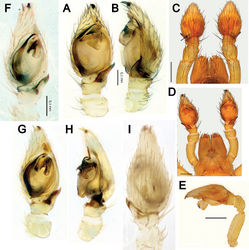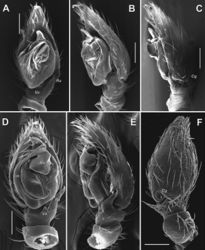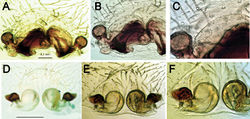Acanthinozodium niusha
| Notice: | This page is derived from the original publication listed below, whose author(s) should always be credited. Further contributors may edit and improve the content of this page and, consequently, need to be credited as well (see page history). Any assessment of factual correctness requires a careful review of the original article as well as of subsequent contributions.
If you are uncertain whether your planned contribution is correct or not, we suggest that you use the associated discussion page instead of editing the page directly. This page should be cited as follows (rationale):
Citation formats to copy and paste
BibTeX: @article{Zamani2021ZooKeys1035, RIS/ Endnote: TY - JOUR Wikipedia/ Citizendium: <ref name="Zamani2021ZooKeys1035">{{Citation See also the citation download page at the journal. |
Ordo: Araneae
Familia: Zodariidae
Genus: Acanthinozodium
Name
Acanthinozodium niusha Zamani & Marusik, 2021 sp. nov. – Wikispecies link – ZooBank link – Pensoft Profile
Type material
Holotype ♂ (MHNG), Iran: Markazi Province: Shazand, 33°55'N, 49°24'E, 11.04.2015 (A. Zamani). Paratypes: 5♂3♀ (MHNG), same data as holotype; Isfahan Province: 1♂1♀ (MHNG), Riz-e Landjan, 32°24'N, 51°19'E, 11.08.1973 (A. Senglet); Fars Province: 1♂1♀ (MHNG), Izad Khast, 31°31'N, 52°08'E, 12.06.1974 (A. Senglet).
Etymology
The specific epithet is a Persian feminine name meaning “good listener”. Noun in apposition.
Diagnosis
The male of the new species is most similar to A. parysatis sp. nov. from which it differs by a sharply tapering RTA, shorter tip of the cymbium (cf. Fig. 13A and 13F), the angle of embolus and the claw of the median apophysis. Female of A. niusha sp. nov. is similar to A. atrisa sp. nov. by having a similar anterior hood but differs by the longer furrow leading to the hood (as long as receptacle vs. 1.5 times shorter) and less separated receptacles.
Description
Male (holotype). Habitus as in Fig. 11C, D. Total length 2.09. Carapace 0.94 long, 0.46 wide at pars cephalica, 0.69 wide at pars thoracica. Eye sizes and interdistance of PMEs: AME: 0.10, ALE: 0.07, PME: 0.06, PLE: 0.06, PME–PME: 0.12. Carapace, sternum, labium, chelicerae and maxillae yellowish; carapace with irregular dark patterns. Chelicera with one retromarginal tooth. Legs yellowish, without annulations. Abdomen dorsally black, grayish ventrally. Spinnerets pale, uniform in color. Measurements of legs: I: 1.67+missing tarsus (0.74, 0.31, 0.62, missing), II: 2.56 (0.66, 0.30, 0.52, 0.59, 0.49), III: 2.43 (0.60, 0.33, 0.46, 0.59, 0.45), IV: 3.43 (0.90, 0.31, 0.81, 0.89, 0.52).
Palp as in Figs 13A–E, 14G, H, 15D–F. RTA (Ra) as long as wide and as long as tibia, basal part very wide, sharply tapering, tip bent ventrally; cymbium 1.5 times longer than wide; posterior part of tegulum with broad and indistinct projection postero-prolaterally; median apophysis (Ma) with massive base, much larger than the claw of median apophysis; sperm duct gradually tracking along margin of tegulum; tip of embolus (Em) straight and lacking any processes or tubercles. Female. Habitus as in Fig. 11E. Total length 2.10. Carapace 0.86 long, 0.44 wide at pars cephalica, 0.69 wide at pars thoracica. Eye sizes and interdistance of PMEs: AME: 0.07, ALE: 0.06, PME: 0.05, PLE: 0.05, PME–PME: 0.10. Coloration as in male. Measurements of legs: I: 2.68 (0.73, 0.30, 0.59, 0.61, 0.45), II: 2.58 (0.74, 0.24, 0.53, 0.58, 0.49), III: 2.32 (0.59, 0.29, 0.50, 0.55, 0.39), IV: 3.45 (0.89, 0.33, 0.80, 0.92, 0.51).
Epigyne as in Fig. 17A–C. Fovea about 3 times wider than long; hood as wide as fovea, bursae ovoid, weakly sclerotized, with fine pores (Fig. 17C); receptacles round, spaced by over 5 diameters.
Distribution
Known only from the listed localities in Fars, Isfahan and Markazi provinces, central Iran (Fig. 32).
Original Description
- Zamani, A; Marusik, Y; 2021: Revision of the spider family Zodariidae (Arachnida, Araneae) in Iran and Turkmenistan, with seventeen new species ZooKeys, 1035: 145-193. doi
Images
|





